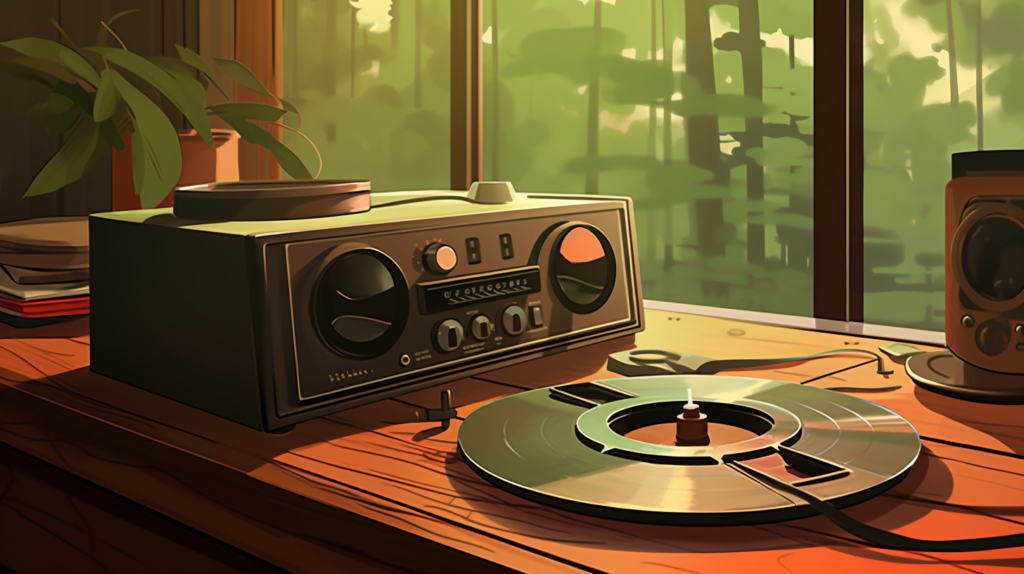
The Essence of Vintage Keys
When you conjure the sound of vintage keys, there’s a certain warmth that envelops the heart of the music—a richness that modern synths often strive to emulate. Serum, with its intricate wavetable capabilities, stands as a formidable tool to sculpt these deeply resonant and nostalgic tones. As you embark on this journey to capture the essence of eras past, remember, it’s not just about replication; it’s about reimagining those classic sounds through the lens of today’s technology.
Vintage keys bring forth memories of analog gear, each with its unique timbre and soul. To truly honor these sounds in Serum, you need to think beyond presets. Consider the hardware that birthed these sounds—the robust Moogs, the choral Mellotrons, and the soulful Rhodes. These instruments were not pristine; they had character, often flavored by the imperfections of their circuitry and age.
Now, let’s dive headfirst into Serum’s architecture, shall we? The first step is to deconstruct the iconic waveforms that served as the foundation for those timeless tones. Your oscillators are not just tone generators; they are your time machines. By meticulously selecting and warping waveforms that exude a vintage character, you craft the base from which all else flows. Pay close attention to the subtle uses of drift and detune, creating the illusion of aged oscillators that refuse to stay in perfect unison.
As you experiment, let your ears be the judge. Each tweak in Serum should be a step toward that warm, analog embrace. The magic is often in the minutiae—the gentle roll-off of a low-pass filter, the slightest boost in the mids to bring forward the body of the sound, or the judicious use of built-in saturation to replicate the glow of tubes and tape. You’re not just twisting knobs; you’re breathing life into your music, instilling each note with the vintage soul that has captivated generations.
Advanced Oscillator Manipulation
In the realm of Serum sound design, the oscillator serves as your canvas, and with it, you can paint the broad strokes of vintage charm. Your task is to manipulate these oscillators to achieve a sound that’s not just old, but timeless. This is where your advanced skills truly come to play. You’re no novice; you understand the power of Serum’s wavetables and the flexibility they offer.
To initiate this sonic time travel, start with the selection of wavetables that mimic the harmonic content of vintage synths. Serum offers a myriad of choices, but for that retro touch, you might lean towards those with a smoother, more rounded character. It’s all about finding the right balance—too much complexity and you lose the essence; too little, and the sound falls flat.
Delve into Serum’s ability to morph these wavetables. Imagine blending the organic fluctuations of an old analog synth with the precision of Serum’s engine. You could start with a simple sine wave, layer it with a triangle, and slowly introduce harmonics that remind you of a bygone era. The trick is to use Serum’s warp modes creatively—perhaps a touch of ‘Bend+’ or ‘Asym+’ to skew the waveform in a way that an old oscillator might have naturally drifted.
Layering is your secret weapon here. Think of each oscillator as a voice from the past, and as you layer them, you create a choir, rich and lush. But be cautious; too many voices and the choir becomes a cacophony. You’re aiming for a symphony of simplicity, where each oscillator contributes to a greater whole without overwhelming it.
Remember, the goal is to reach that sweet spot where each adjustment you make—a detune here, a warp there—brings you closer to the warm, embracing sound of vintage keys. It’s a delicate dance between innovation and tradition, and you, as the maestro of Serum, are leading the performance.
Filter and Modulation Mastery
Diving deeper into Serum’s heart, the filter section beckons, promising the coveted warmth that vintage synth aficionados yearn for. Your mission is to harness Serum’s filters to not only recreate but also redefine the tonal quality of yesteryear’s keys. The key to achieving this lies in the interplay between Serum’s versatile filter models and your modulation prowess.
The iconic low-pass filter, a staple in vintage synthesis, is where you’ll often start. But as an advanced user, you’ll go beyond the basics, carefully sculpting the filter’s envelope to mirror the response of a classic analog machine. You’ll find joy in playing with the drive and resonance controls, pushing them until they spill into the realm of subtle, harmonically rich distortion, reminiscent of overdriven hardware.
Modulation is the lifeblood of dynamism in sound design. Serum’s LFOs and envelopes offer a vast landscape for experimentation. Imagine using an LFO to simulate the irregularities of an old capacitor or employing an envelope to mimic the attack characteristics of a well-loved keybed. It’s about recreating the imperfections that digital synths often overlook. You could even assign velocity to filter cutoff, ensuring that each note you play breathes with the variability that analog is known for.
In Serum, modulation possibilities are boundless. Assign LFOs to pitch for a gentle, seasick warble, or to wavetable position for evolving textures. The modulation matrix is your playground, and with each connection you make, the past and the present converge, creating a tapestry of sound that is as unpredictable as it is beautiful.
The Art of Vintage Keys Unison and Voicing
The unison feature in Serum can be a gateway to the past, emulating the chorus-filled halls of vintage polyphony. You understand that it’s not about the number of voices, but how they interact. To craft a sound that’s reminiscent of analog days, you’ll employ unison with a strategic approach to detuning, spreading, and blending.
Voicing in Serum is not just about thickness; it’s about character. By detuning the voices slightly, you introduce a natural, beating effect that echoes the inconsistencies of vintage synths. You might find yourself tweaking the detune knob until the sound starts to shimmer, just on the edge of chaos, much like an ensemble effect found in classic string machines.
The real artistry comes in the subtle manipulation of Serum’s voicing parameters. Portamento and mono modes can transform a patch from a stabby clavinet-like bark to a smooth, legato glide that harks back to the soulful leads of the ’70s. Your deliberate choices in the voicing tab imbue your patches with a sense of history—a nod to the analog giants upon whose shoulders we now stand.
By now, the stereo image of your keys is starting to take shape, breathing with the life of unison voices. You tweak the spread, balancing the width with the focus, ensuring that your vintage keys can stand alone or fit within a dense mix. This is the detail that takes your Serum patches from mere sounds to stories, each note a narrative in itself.
Serum’s FX Rack for Vintage Keys Authenticity
Your voyage through Serum’s capabilities now leads you to the FX rack, an arsenal of sonic modifiers that can imbue your patches with the grain and grit of a bygone musical era. Here, you’ll find the power to add layers of warmth and imperfections that echo the analogue equipment of yesteryear.
You might start with the Hyper/Dimension module, using it sparingly to add just a hint of depth and movement, reminiscent of the natural chorus and ensemble effects of old synthesizers. But the real charm comes in when you engage the Distortion unit. Here, by selecting the right type of distortion and carefully calibrating the drive and mix knobs, you can introduce harmonics that scream vintage. It’s the difference between a sterile digital sound and one that has the dusty fingerprints of the 70s and 80s all over it.
The Tube and Tape saturation models within the Distortion module are particularly adept at simulating the warmth that’s so characteristic of vintage keys. The trick is to dial in the saturation to the point where it enhances the sound without overtaking it. Remember, we’re painting with sound, not slathering it.
You can’t discuss vintage sound without a nod to the Reverb and Delay modules. With a focus on convolution reverbs that emulate real spaces and analogue-style delays that degrade with each repeat, you bring a sense of history into your patches. The idea is to use these effects to place your sounds in a context that feels like it’s been lifted from a dusty vinyl.
The Compressor in Serum, especially in multiband mode, can be thought of as a time machine. Use it to glue together the elements of your patch, just as vintage compressors lent a cohesive feel to the classic records. With the right attack and release settings, your keys can punch through a mix with a presence that feels both old-school and fresh.
Creative Sampling and Noise Techniques
Serum is not just a wavetable synth; it’s a hybrid instrument that allows for the injection of custom samples. This feature becomes a secret weapon when aiming for the authentic feel of vintage keys. By integrating samples from classic instruments or even vinyl crackle, you introduce a layer of authenticity that pure synthesis sometimes struggles to achieve.
The Noise Oscillator in Serum is typically used to add breath or grit to a sound, but for the vintage keys enthusiast, it’s a goldmine. You can import samples of mechanical noises from classic keyboards, the hum of an amplifier, or the ambient room noise from old recordings to add a layer of realism that transports the listener back in time.
You might consider using a subtle layer of noise modulated with an LFO to simulate the random character of vintage keys. It’s these touches of realism, the feeling that there’s a real instrument with air moving around it, that can elevate your patches from mere imitations to evocative recreations.
When sampling, the goal is not to overshadow but to complement. It’s about finding the right balance where the samples provide a nostalgic backdrop, allowing the synthesized elements of your patch to shine through. This technique requires a nuanced touch, a sense of how to blend the old with the new to create something that is both familiar and novel.
As you navigate through Serum’s sample and noise capabilities, you’re not just a sound designer; you’re a curator of sonic history, selecting and layering sounds that bring the past into the present with tact and taste. Each choice you make, from the sample you select to the way you modulate it, writes a new chapter in the story of vintage keys.
Advanced Envelope and LFO Applications
In the landscape of Serum’s sound design possibilities, envelopes and LFOs are the tools that breathe life into your patches. But as an adept sound sculptor, you’re not content with standard modulations. You seek to employ these tools in innovative ways that inject vintage life into every corner of your sound.
Start with the envelopes. In Serum, they’re not just for shaping amplitude or filter cutoffs; they’re for sculpting a performance. You can craft an envelope that mimics the sluggish attack of a vintage Wurlitzer or the snappy decay of an old clavinet. Adjust the hold and delay parameters to simulate the response time of ancient keys being pressed by seasoned fingers.
LFOs in Serum can be your rhythmic guides, but when used unconventionally, they become your vintage storytellers. Set an LFO to modulate the pitch ever so slightly to recreate the inherent instability of old oscillators. Assign another to gently wobble the filter cutoff, lending a sense of movement that feels like the warm breath of a Leslie speaker.
By drawing custom LFO shapes, you can go beyond typical modulations and create patterns that reflect the idiosyncrasies of vintage hardware. Imagine an LFO shape that mimics the irregular power supply of a synth from the ’70s, introducing a pulsating life force into your sound. The aim is to craft an experience so authentic that the listener can almost smell the dust on the keys.
Remember, in Serum, your modulation assignments can be as complex or as straightforward as you desire. It’s about using these advanced tools to echo the past while creating something that’s undeniably yours. This is where the true art of vintage synthesis lies—not just in the sound itself but in the movement and the story it tells.
Tweaking and Fine-Tuning
As you delve deeper into the nuances of Serum, tweaking and fine-tuning become more than mere adjustments—they become expressions of your artistic intent. You’re not just tweaking for the sake of precision; you’re fine-tuning to capture the essence of a time when synths were as temperamental as they were expressive.
Fine-tuning in Serum is a delicate process. It’s about refining the interplay between oscillators, finding the perfect balance where they sit in harmony, yet retain their distinct character. It’s about dialing in the exact modulation rate that makes your sound wobble with vintage authenticity.
Each parameter in Serum holds the potential to bring you closer to the vintage sound you’re after. The warp modes, the unison detune, the filter drive—they all contribute to the tapestry of your sound. Even the smallest adjustment can have a profound impact, like finding the precise key tracking setting that makes your filter open up just as an old keyboard might under the fingers of a soulful player.
Then there’s the fine-tuning that happens outside of Serum. How does your patch sit in the mix? Does it complement the other elements, or does it stand out with too much modern sheen? This is where you apply your studio acumen, using equalization to roll off the sterile highs or applying vintage-style compression to glue the sound together.
This is your time to be meticulous, to be thoughtful. You’re not simply a producer; you’re a sonic alchemist, turning the digital precision of Serum into the gold of vintage warmth. Every subtle tweak, every refined setting is a step towards achieving that elusive sound that bridges decades.
Mixing and Matching with Modern Elements
When you infuse vintage keys with modern production techniques, you’re engaging in a form of sonic alchemy. This cross-era synthesis allows you to maintain the soulful essence of the past while ensuring your sound cuts through the contemporary mix with clarity and presence.
In this nuanced dance, the goal is to mix and match with intention. You may layer a Serum patch that resonates with the thickness of a Juno chorus alongside a crisp, digital pluck for contrast. It’s about striking a balance where the warmth of the vintage doesn’t overpower the track’s modern edge. You’re curating a soundscape where the old and new coexist, not just in harmony, but in a dynamic conversation.
Consider the tempo and rhythm of your track. How can your vintage-style keys complement the modern drum patterns and basslines? It might be a case of syncing LFO rates to BPM or tweaking the attack times to sit perfectly behind a kick drum. The interplay of elements should feel intentional, a deliberate blend that showcases your command over Serum’s vast capabilities.
Don’t shy away from automation. It’s a powerful tool that can bring movement to your patches. Automate the mix level of a reverb to bring your keys from the back of the mix to the forefront for a section, or sweep the cutoff to transition from a modern sound to a vintage one. These dynamic changes keep the listener engaged, taking them on a journey through time with each twist and turn.
Inspiration and Case Studies
Now, let us take a moment to reflect on the artists who have paved the way, the iconic tracks that serve as our guideposts. These case studies are not just songs; they’re blueprints of how vintage keys have been immortalized in music. Analyzing these can provide invaluable insights into how you might shape your Serum patches.
Take, for example, the creamy pads of a Vangelis composition. By dissecting the layers, understanding the modulation, and the expressive use of aftertouch, you can reverse-engineer similar sounds within Serum. Or consider the percussive bite of a classic Stevie Wonder clavinet line—what gives it that distinct punch? How can you replicate that articulation and energy within a Serum patch?
These case studies are more than mere emulation exercises; they are opportunities to understand the ‘why’ behind the ‘what’. They challenge you to not just replicate but reinterpret these sounds within the context of modern music production.
Share your findings, too. Be part of the community that pushes Serum to its limits. When you craft a patch that captures the essence of a classic track, don’t keep it to yourself. Share it, along with your process, to inspire others and to keep the evolution of sound design in perpetual motion.
Conclusion
As we wrap up this deep dive into the artistry of creating vintage keys in Serum, remember that the journey doesn’t end here. These pages are just the beginning, a foundation upon which you can build your unique sonic signature. The true beauty of Serum lies in its flexibility, its ability to become a vessel for your creative vision.
The techniques discussed are not rules but tools—starting points for you to bend, twist, and shape to your will. Your patches are more than presets; they are expressions of your artistry, a blend of historical homage and forward-thinking design.
So, take these insights, these advanced tips and tricks, and use them to carve out your path in the realm of sound design. Let the past inspire you, but always keep an ear to the future. After all, the sounds we consider vintage were once the cutting edge. Who knows? The patches you create today might be the vintage sounds of tomorrow.





